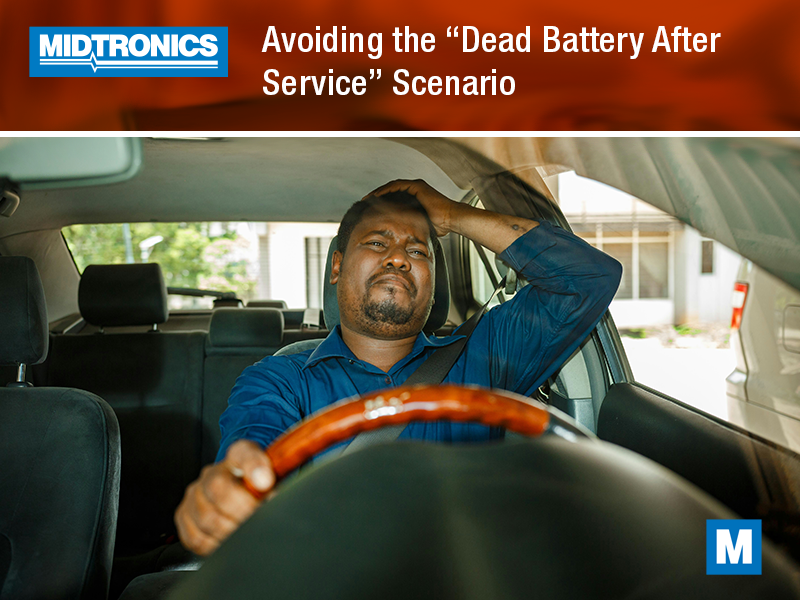Nobody gets excited about warranties. But when a customer’s 12-volt battery dies unexpectedly, they suddenly want to know exactly what’s covered, how much they owe (if anything), and whether they’re being treated fairly.
As service advisors and managers, you’re often the one delivering that news. And the way you explain battery warranties can make the difference between a loyal customer and a frustrated one. So, let’s break down what’s actually covered, how pro-rated warranties work, and how to communicate it clearly for both factory-installed and replacement batteries.
Factory-Installed (OEM) Battery Warranties: Know the Basics
When a new vehicle is sold, the 12-volt battery that comes with it is usually covered under the vehicle’s new car warranty, but seldom for the full term.
Most automakers treat the battery as a wear-and-tear item, similar to brake pads or wiper blades. As a result, coverage for the OEM battery is often limited to 12 months or 12,000 miles, whichever comes first. Some luxury brands or extended coverage plans may offer up to 48 months, but it’s rare.
It’s important to note that once that time or mileage limit is up, the factory battery is no longer covered under warranty, even if the vehicle is still within its powertrain or bumper-to-bumper coverage. That often catches customers off guard.
It is one of the criteria that’s listed in the owner’s manual regarding what’s covered under warranty. The problem is that virtually no one reads that section of the manual until they’ve run up against the problem of lack of coverage.
Replacement Batteries: Dealership vs. Aftermarket Coverage
When a vehicle needs a new 12-volt battery, customers typically have two paths: an OEM replacement at a dealership, or an aftermarket battery. Each route comes with its own warranty terms and expectations.
Dealership Replacement Battery Warranties
Many OEMs offer replacement batteries under their branded parts program like Mopar, Motorcraft, AC Delco, and so on. These often come with a multi-year warranty that looks something like this:
- Free replacement period: 12 months in most cases
- Pro-rated coverage: Months 13 to 60, where the customer pays a percentage based on usage. The pro-rated coverage could be as short as an additional 24 months, or up to a total of 60 months.
The pro-rated portion means if the battery fails in year 4, the customer gets partial credit toward a new one, but not a free replacement.
Aftermarket Battery Warranties
Aftermarket brands offer a wide range of warranty lengths, often posted directly on the label or receipt:
- Entry-level batteries: 1- to 2-year free replacement
- Mid-range to premium batteries: 3-year free replacement with some offering limited pro-rated terms beyond that
These warranties are typically honored nationwide at the associated chains, which can be convenient for drivers who relocate or travel often.
What Is Pro-Rated Coverage?
Here’s where the confusion usually starts. A pro-rated warranty is a sliding-scale agreement: the longer the battery has been in use, the less credit the customer receives toward a replacement.
Let’s say a battery has 36 months of full coverage and an additional 48 months of pro-rated coverage. If the battery fails in month 50, the customer won’t pay full price for the new one, but they won’t get it free, either. Instead, they’ll pay a portion based on how much life the battery already provided. Often, the minimum amount they’ll pay is 50% of the new price, then dropping month by month until the coverage period is over.
There’s always potential for it to be challenging to communicate how it works to the customer. You can try:
“Think of it like a partial refund based on how much of the battery’s warranty life was used. Since you’re in month 50 of an 84-month warranty, the battery gave you about 60% of its expected life, so you’d pay around 40% of the new battery’s price.”
Some manufacturers apply the credit as a dollar amount, and others calculate it using a replacement cost formula. The important thing is to present it clearly and avoid technical jargon.
When Customers Are Frustrated
Sometimes a customer will be upset because:
- They thought the battery was covered for longer
- They didn’t know there was a pro-rated clause
- The battery failed shortly after the free replacement period
This is your chance to turn the interaction into a win. First, acknowledge that a dead battery is an inconvenience. Then, pull up the warranty terms and show them what their coverage is, conceding that it’s not usually the first detail they’ll notice in the documentation.
With that explained, describe the pro-rated credit clearly. It often helps to explain the full price of the new battery and how much they’ll be required to pay. If it’s available to you, you might consider goodwill coverage if they’re a long-time or high-value customer.
You can also take this opportunity to explain how modern electrical systems can stress batteries more than ever, making periodic battery health checks a smart preventative step.
Using Battery Testing to Document Warranty Claims
When you’re in pro-rated territory, there’s more to it than just taking the customer’s portion of the payment. To claim the remainder from the manufacturer, you’ll need proof that the old battery fails. Having reliable test results from a diagnostic tool like Midtronics is crucial when making a warranty determination. It shows:
- Battery state of charge and state of health
- Whether the battery meets OEM specs
- If the failure is due to a manufacturing defect or external condition like chronic undercharging
Good documentation protects your shop, keeps warranty suppliers happy, and gives the customer peace of mind that the decision is based on data, not guesswork.
Warranty Talk Is a Sales Opportunity
Once the customer understands their coverage, you can build trust by turning the conversation into a consultative sale. This isn’t about upselling for the sake of it. Offer solutions that fit the customer’s needs and driving long-term satisfaction.
Start by explaining the differences between basic, mid-tier, and premium battery options, especially when it comes to warranty coverage and expected lifespan. Customers who plan to keep their vehicles longer may see real value in spending a bit more for a battery with a longer free replacement period.
You can also introduce battery services like terminal cleaning, corrosion protection, or memory saver installations, to increase ticket value while protecting the customer’s investment. Reinforce how a stronger battery with better warranty terms can reduce future inconvenience and potential tow calls.
And don’t forget to recommend regular battery health checks. They help catch problems early and reinforce the value of returning to your shop for ongoing maintenance. A well-informed customer feels empowered, not pressured, and that builds loyalty in a competitive market.
Make It Simple, Make It Clear
Battery warranties can get murky, but your explanation doesn’t have to be. Keep the language simple, focus on value, and use every interaction as a chance to educate the customer and demonstrate your shop’s expertise.
Keep in mind that factory batteries are typically covered for 12 months in most cases, and replacement batteries come with their own full and pro-rated terms that don’t reflect the same as OEM batteries – don’t confuse the two.
The more transparent and informed your battery warranty conversation is, the more confident your customer will feel, and the more likely they’ll be back when the next issue rolls around.
Midtronics can help you back up those conversations with accurate, fast diagnostics that take the guesswork out of battery claims. Because when the message is clear, the service becomes trusted.




